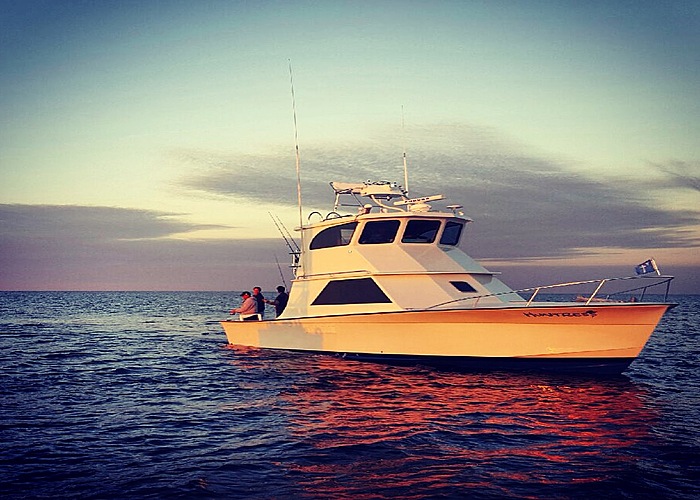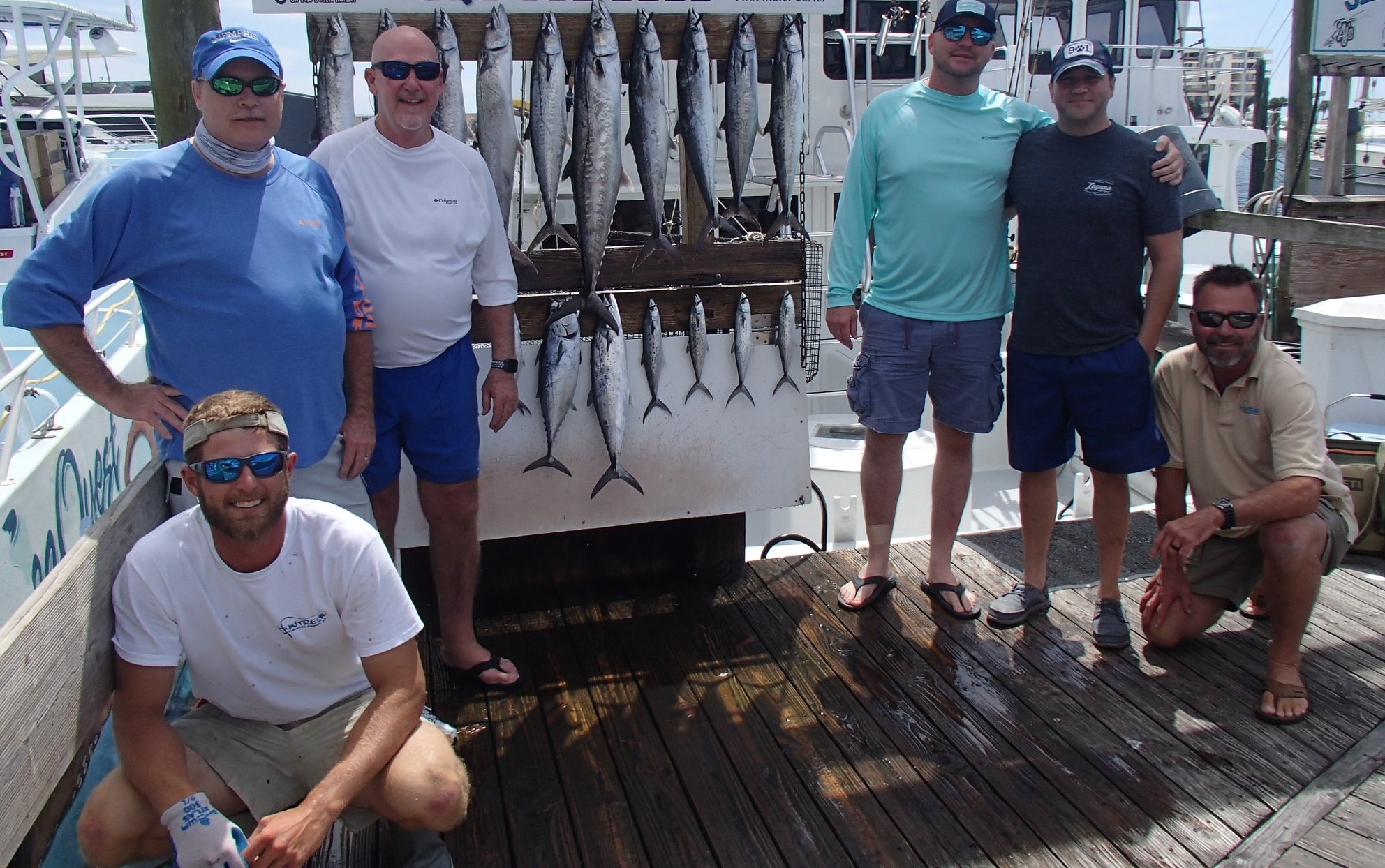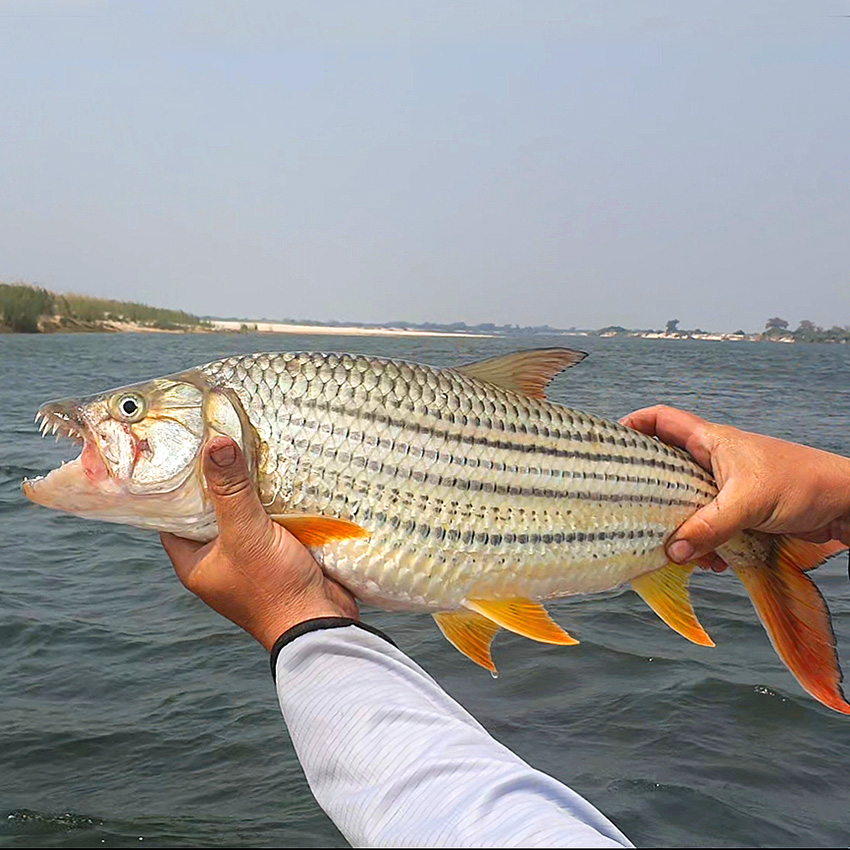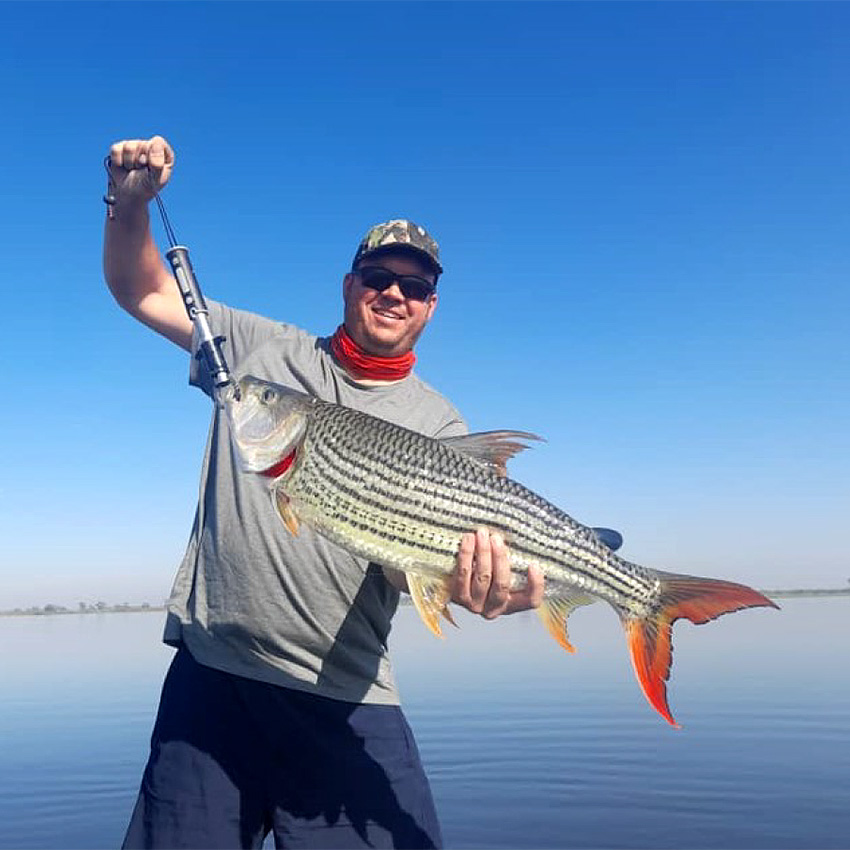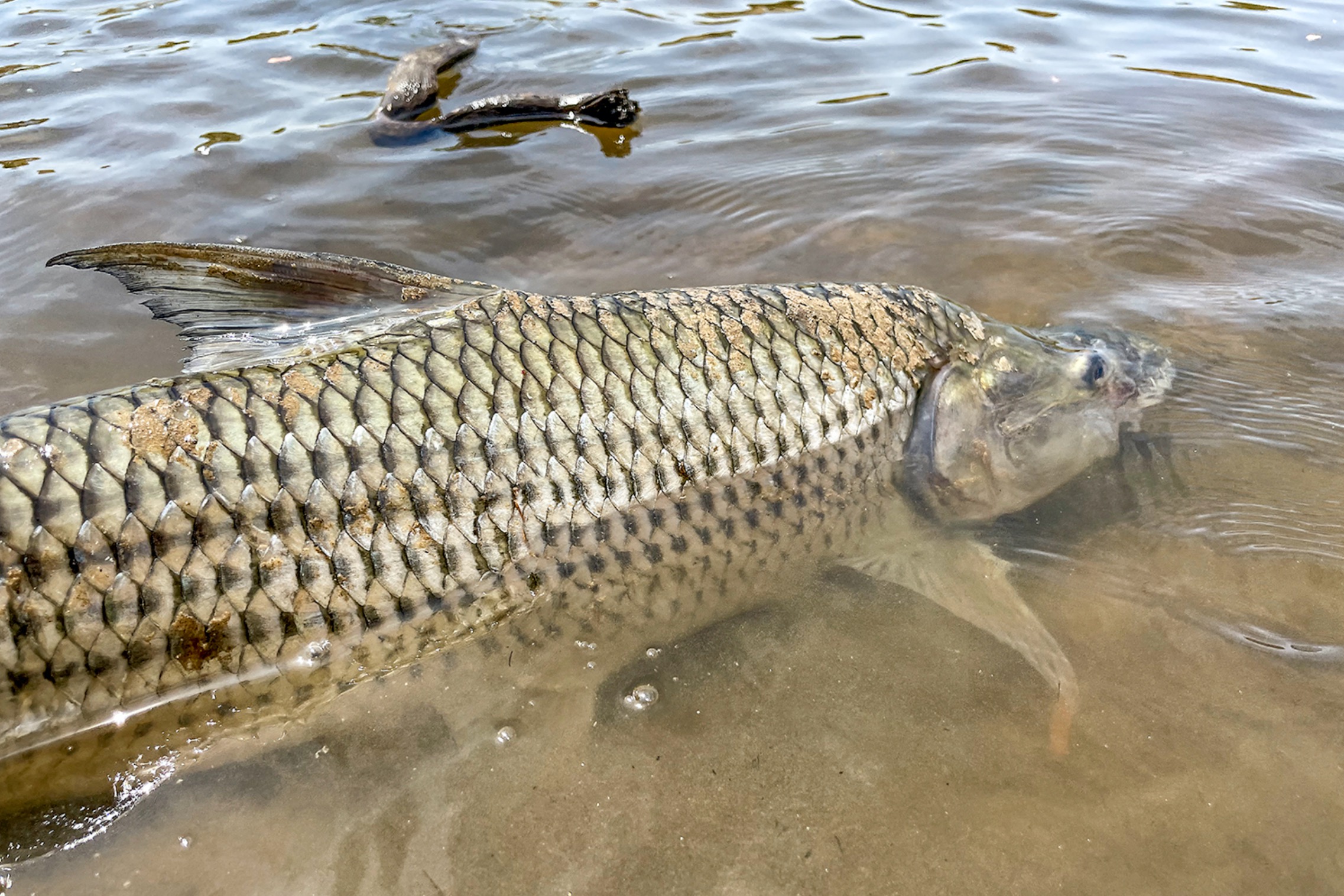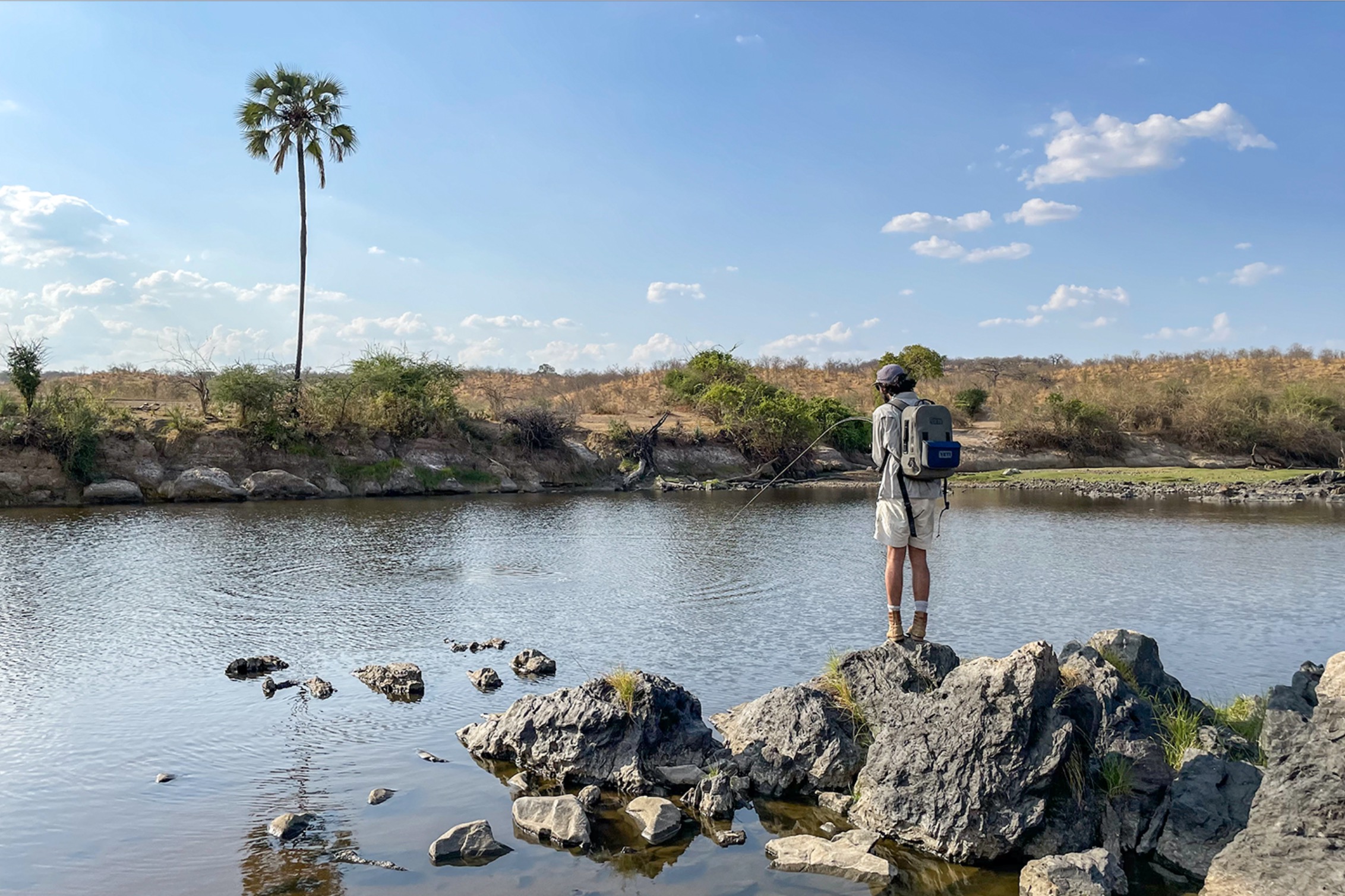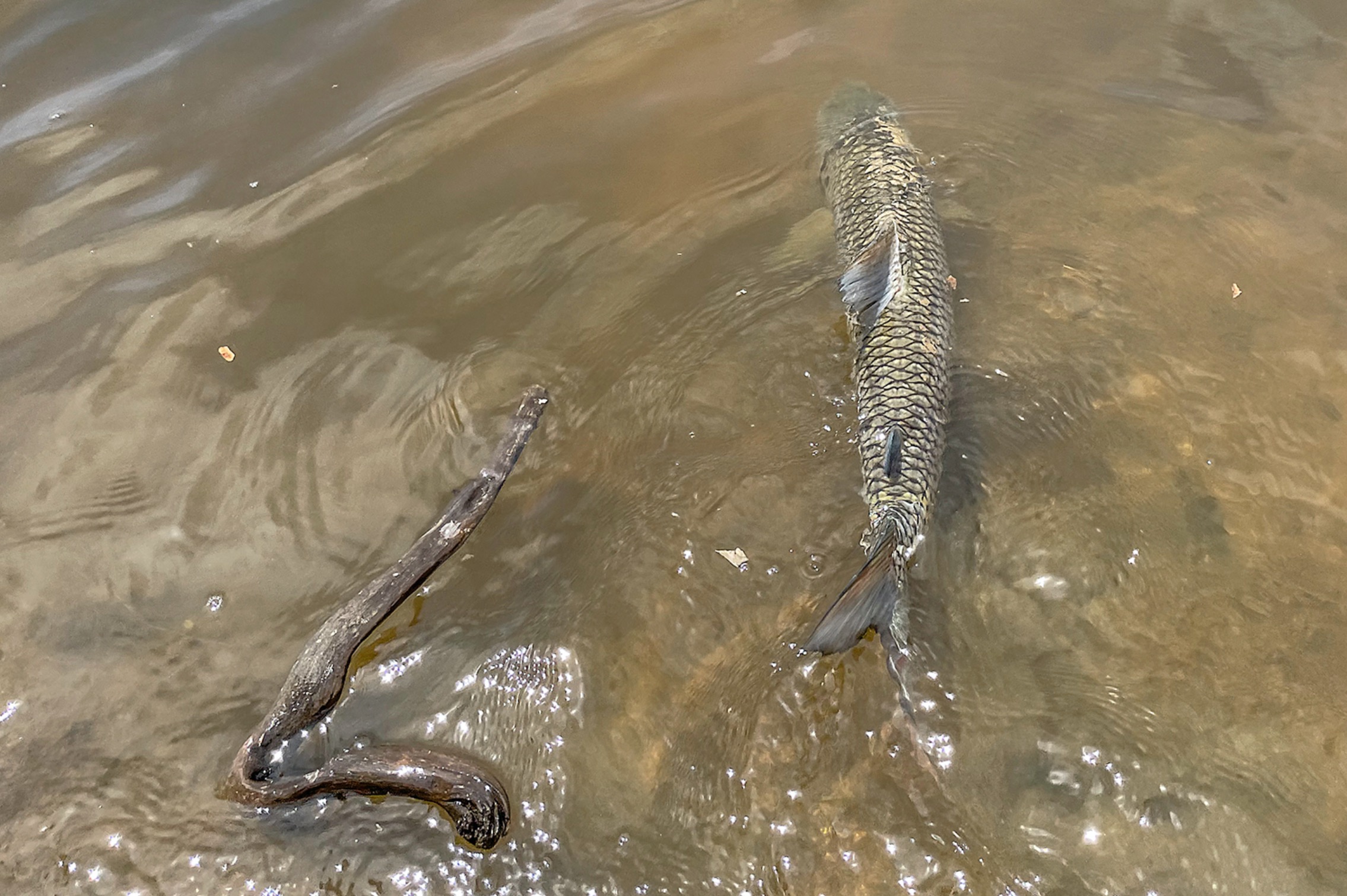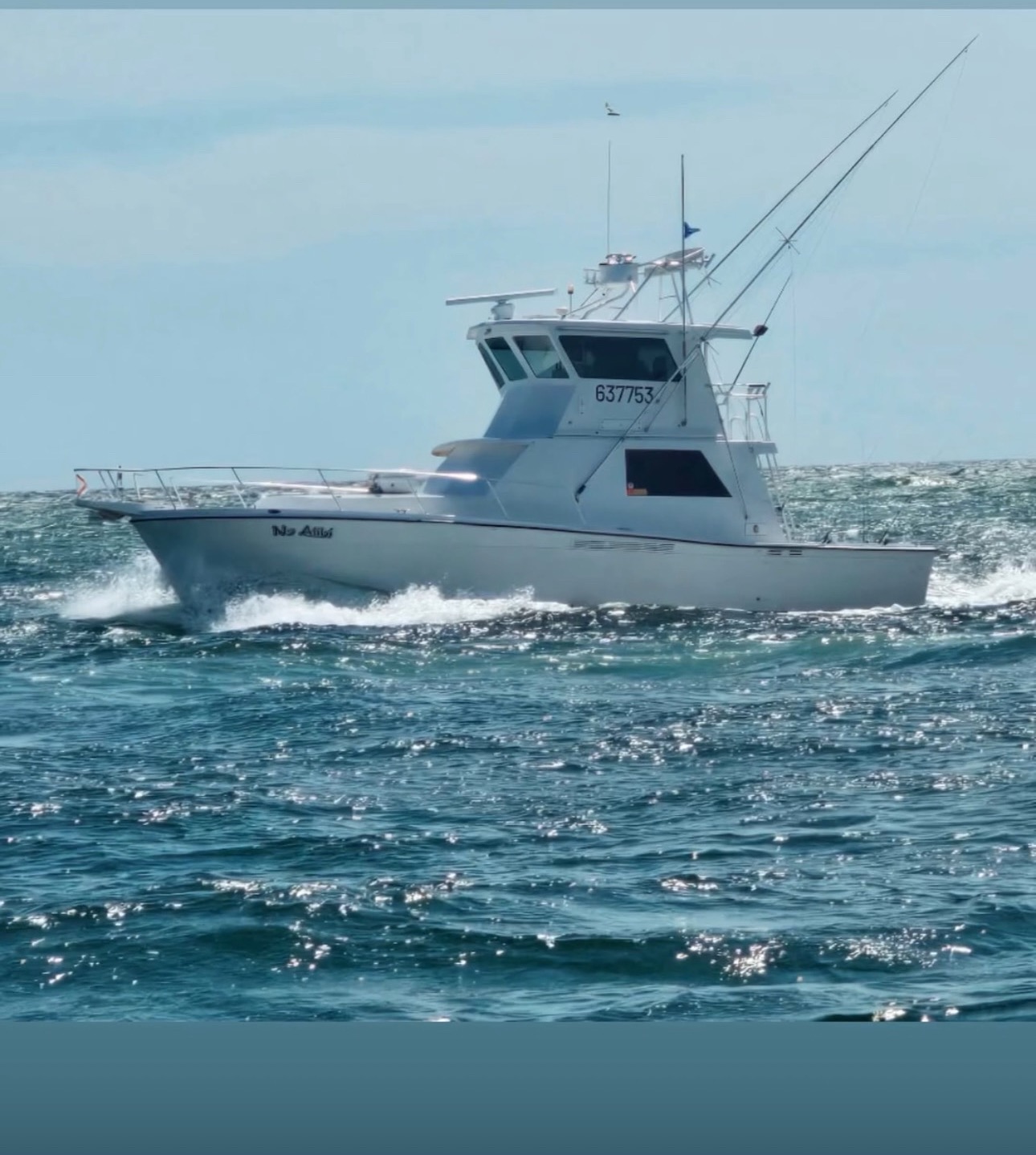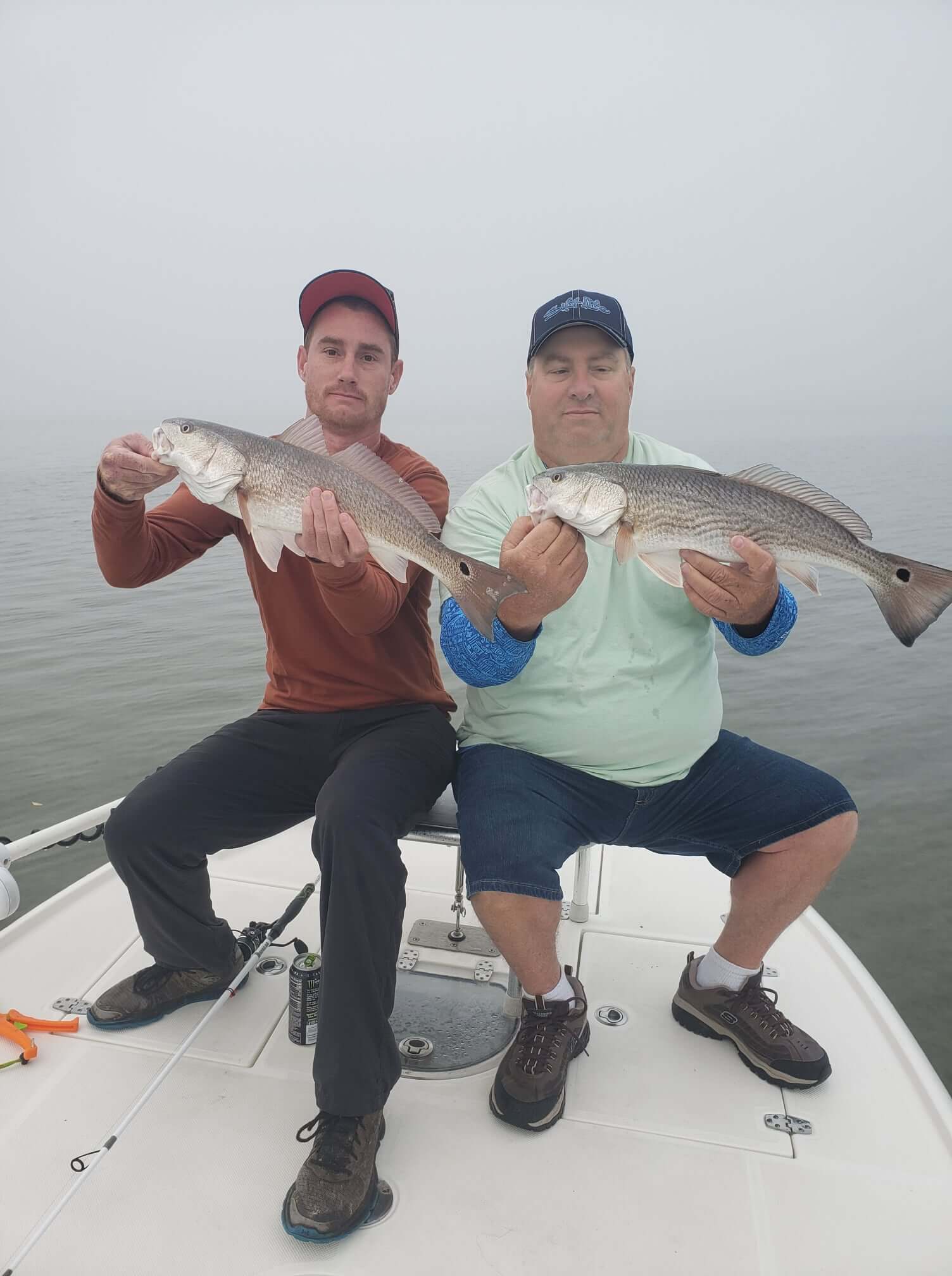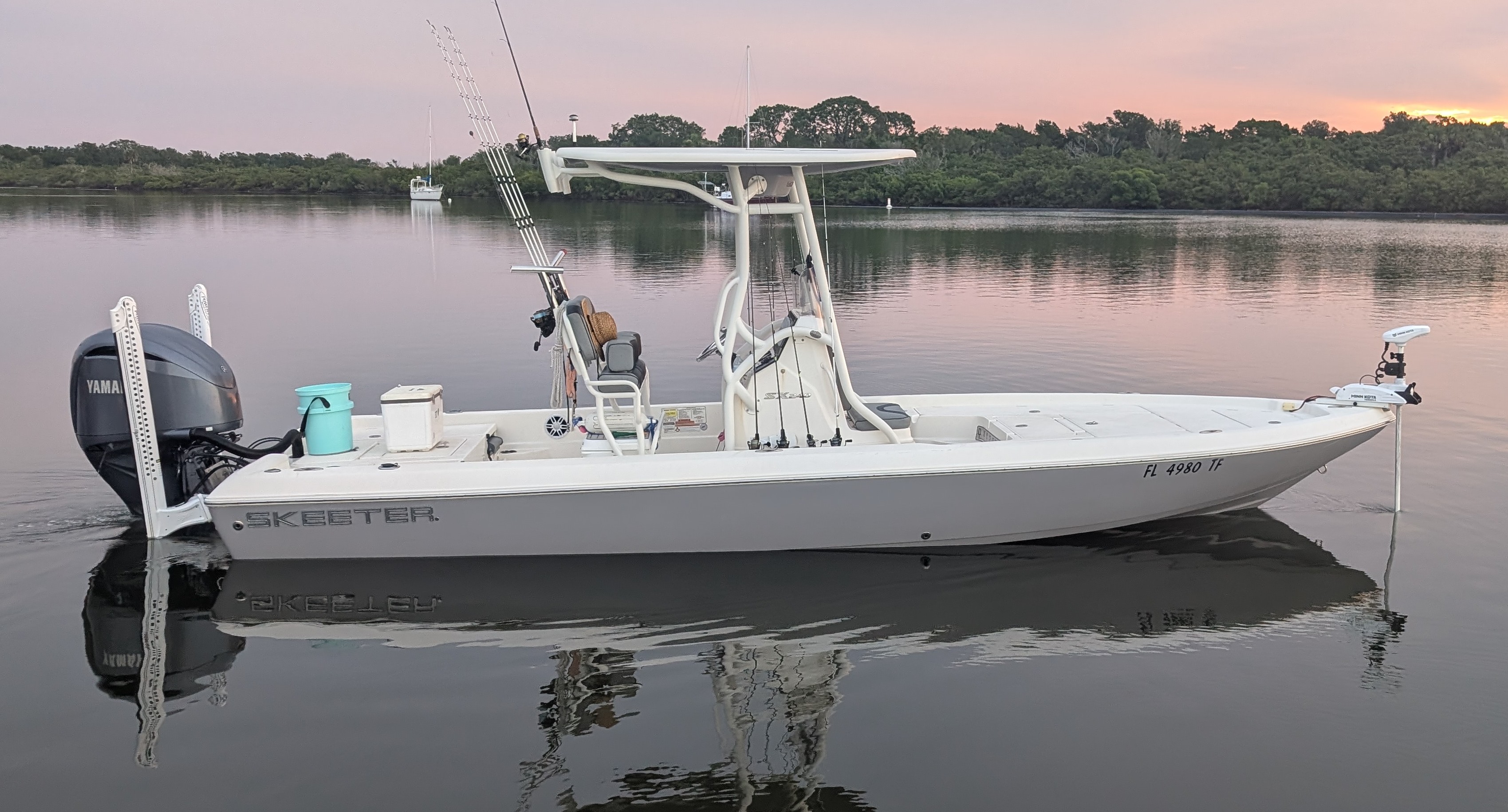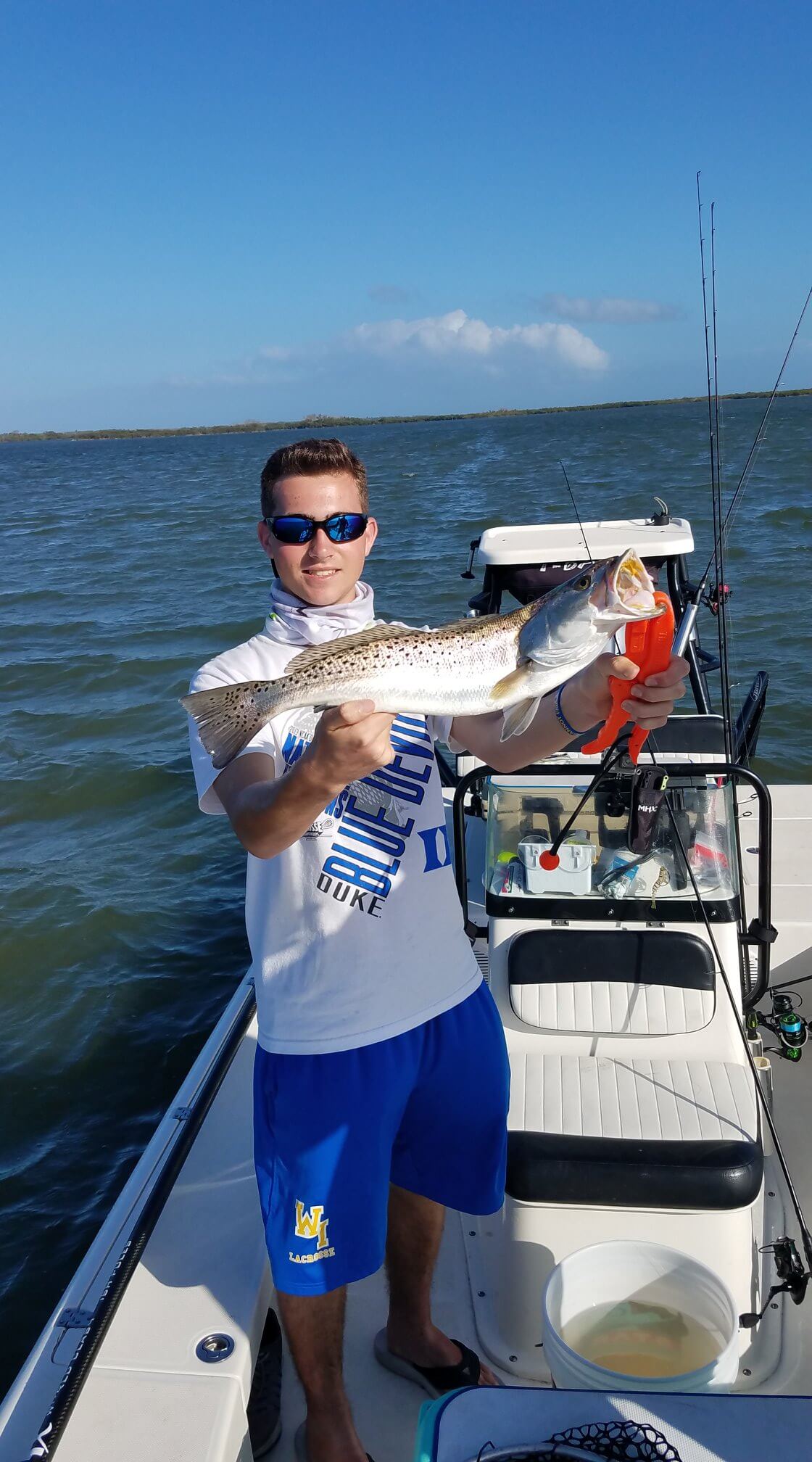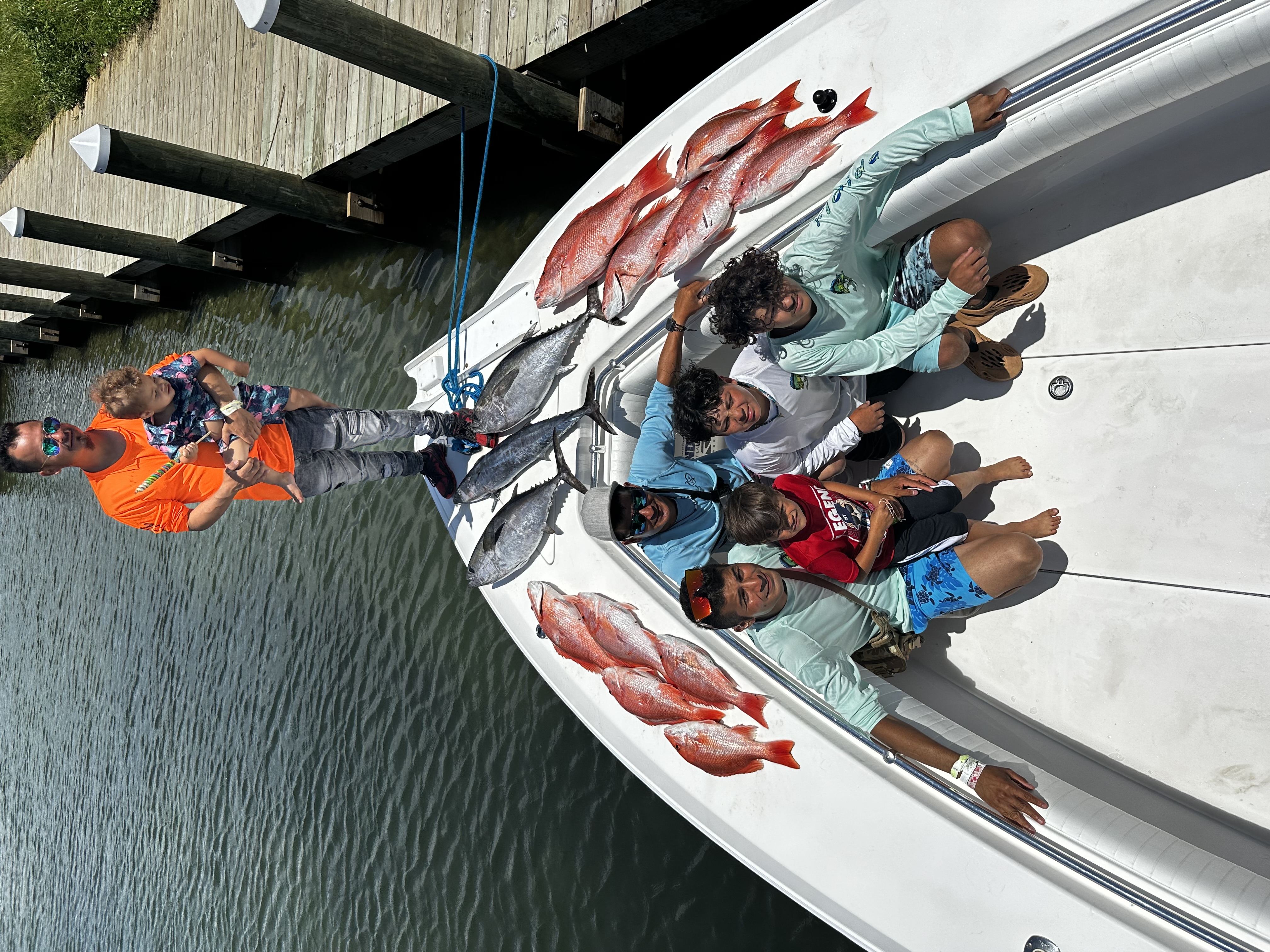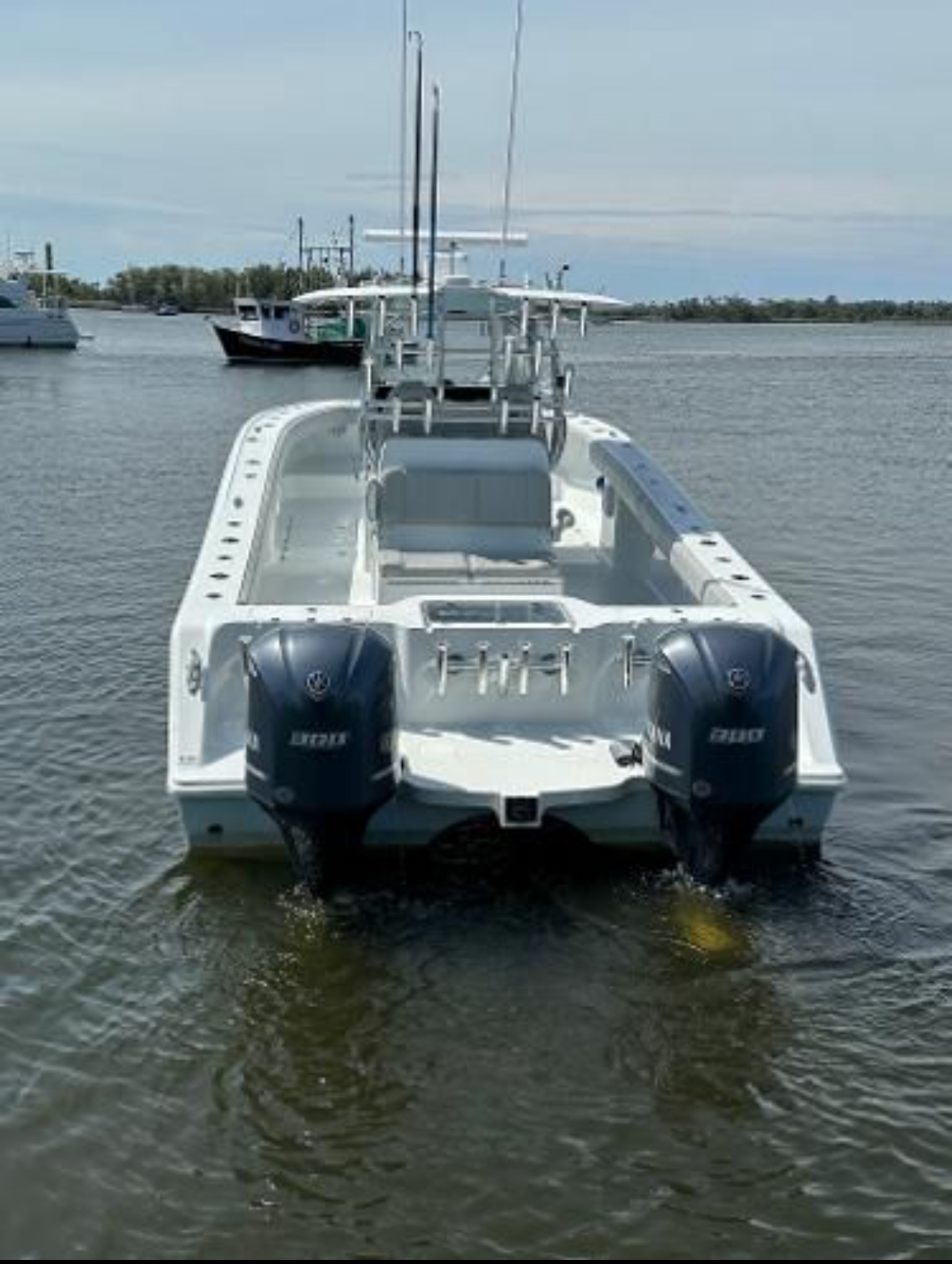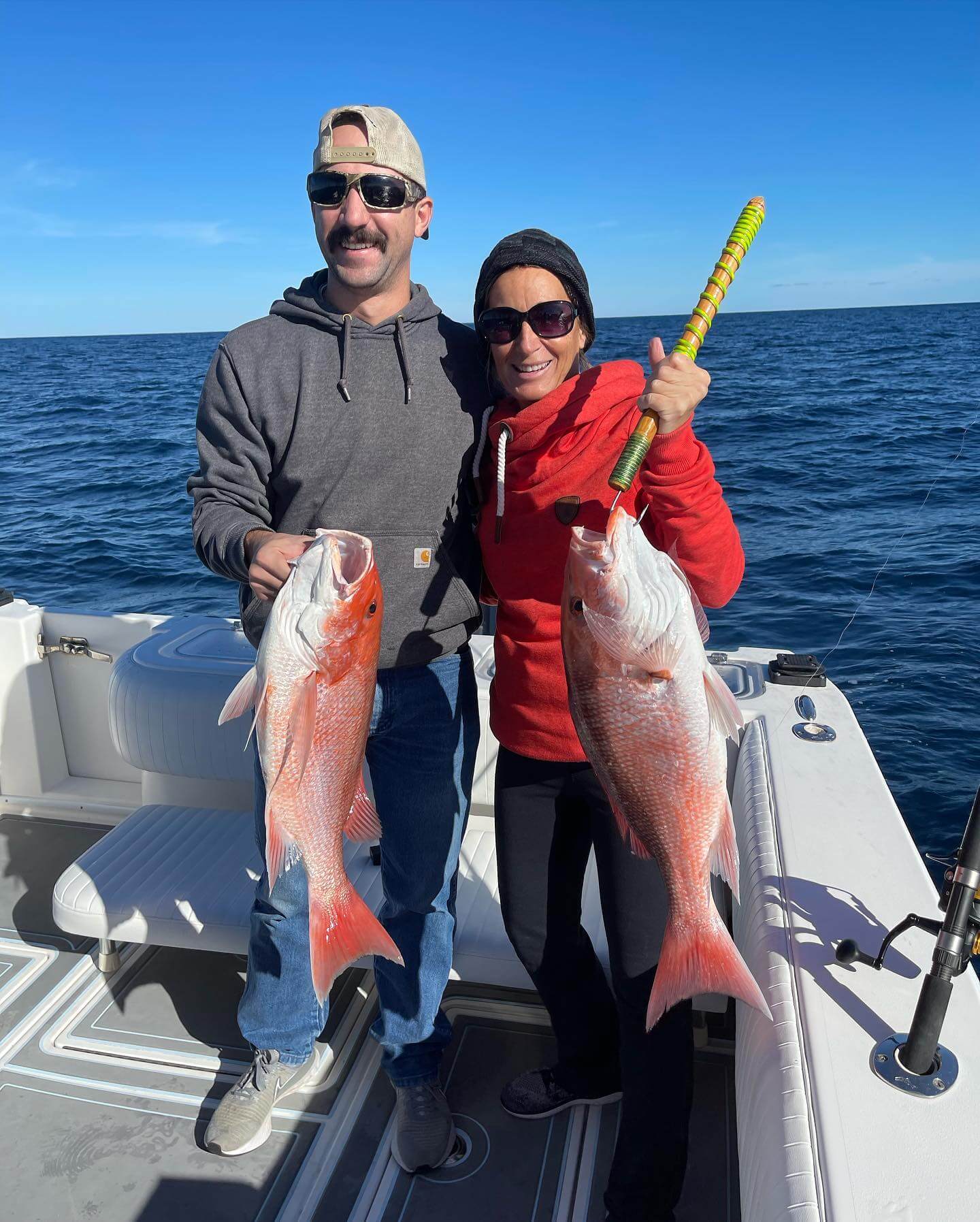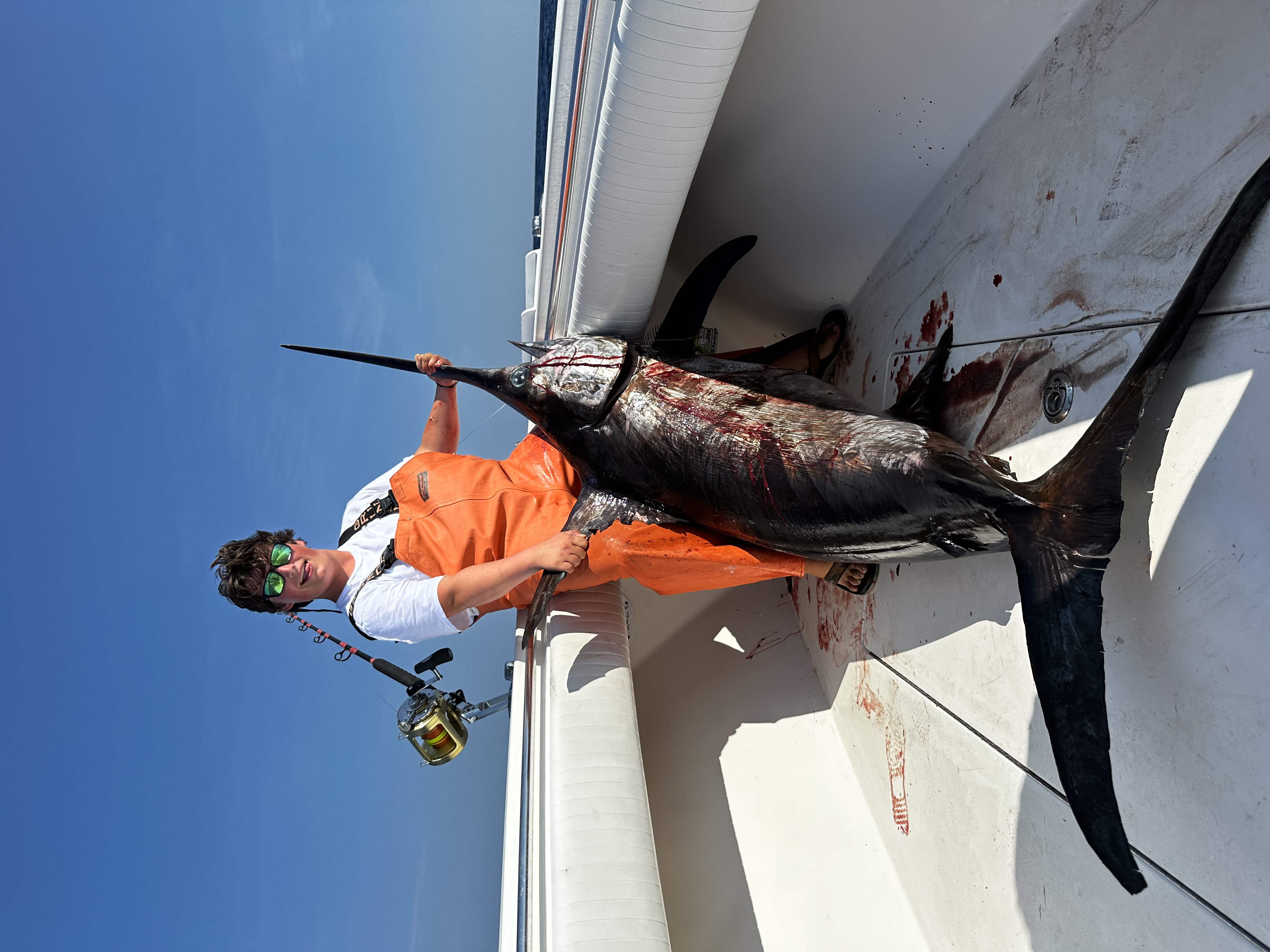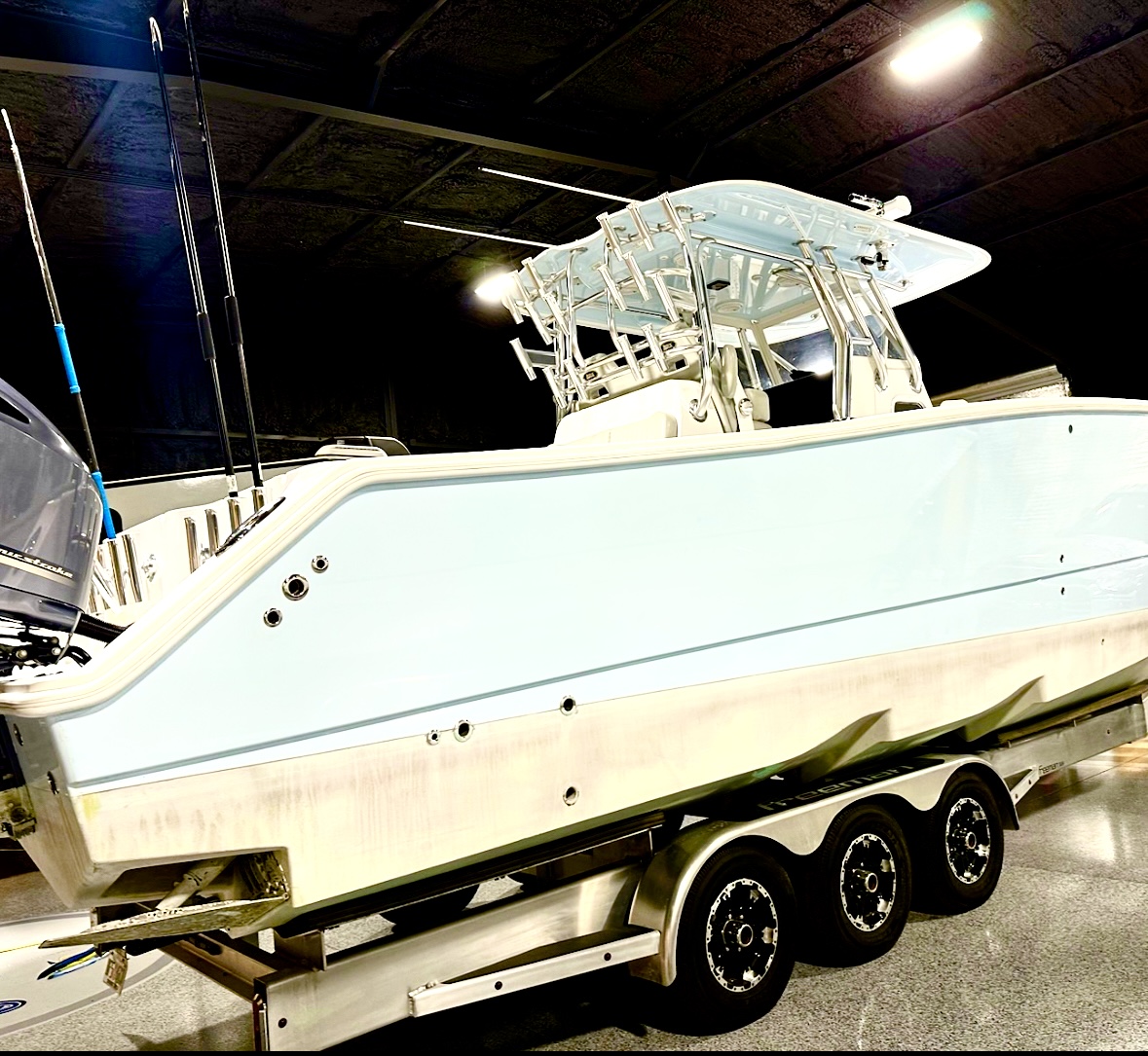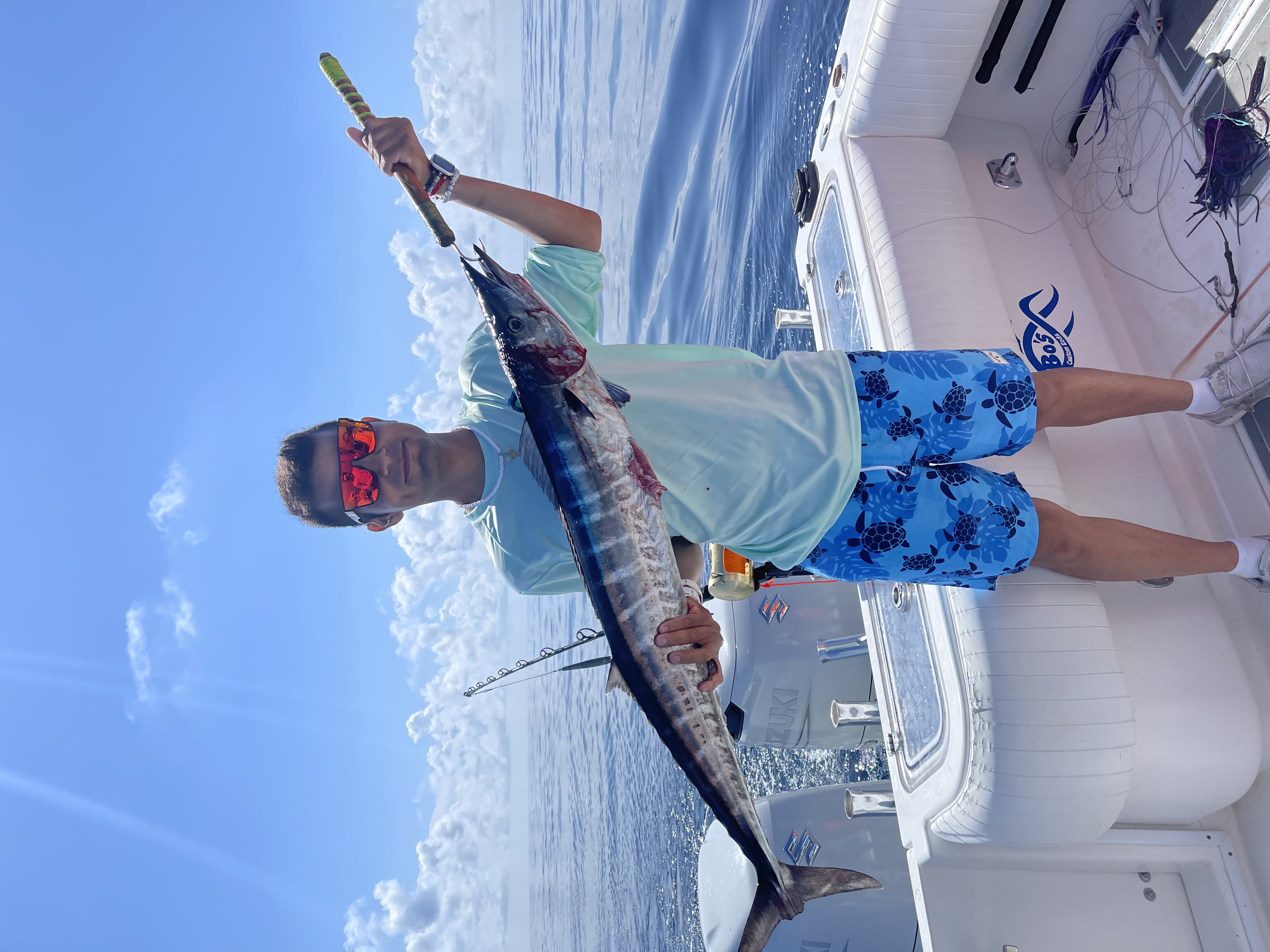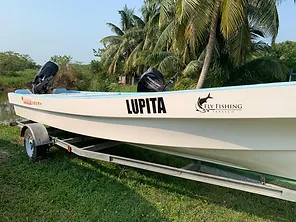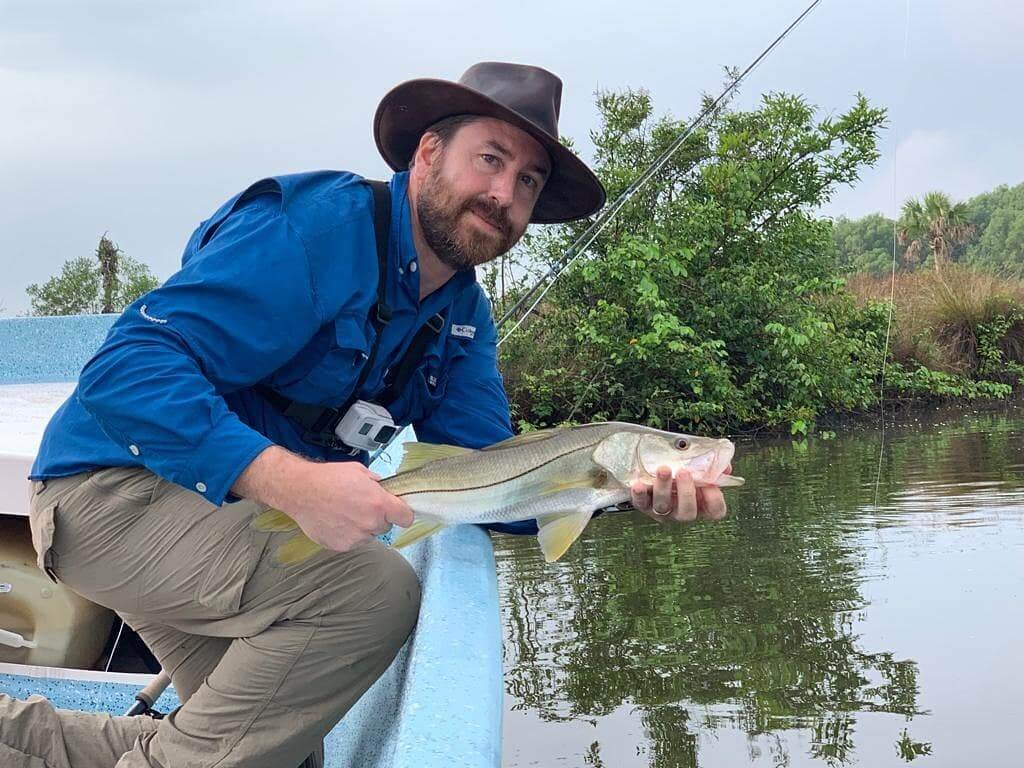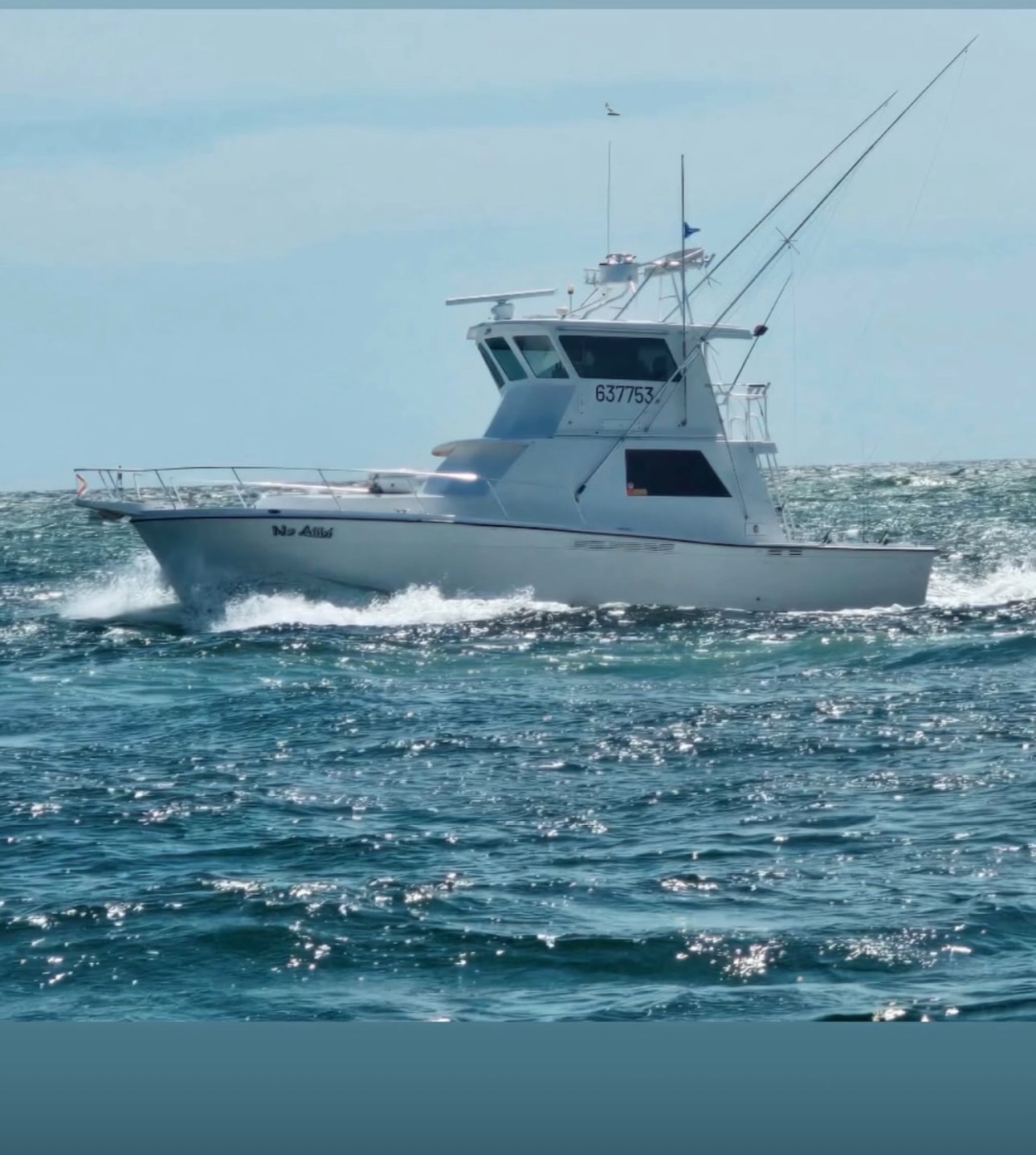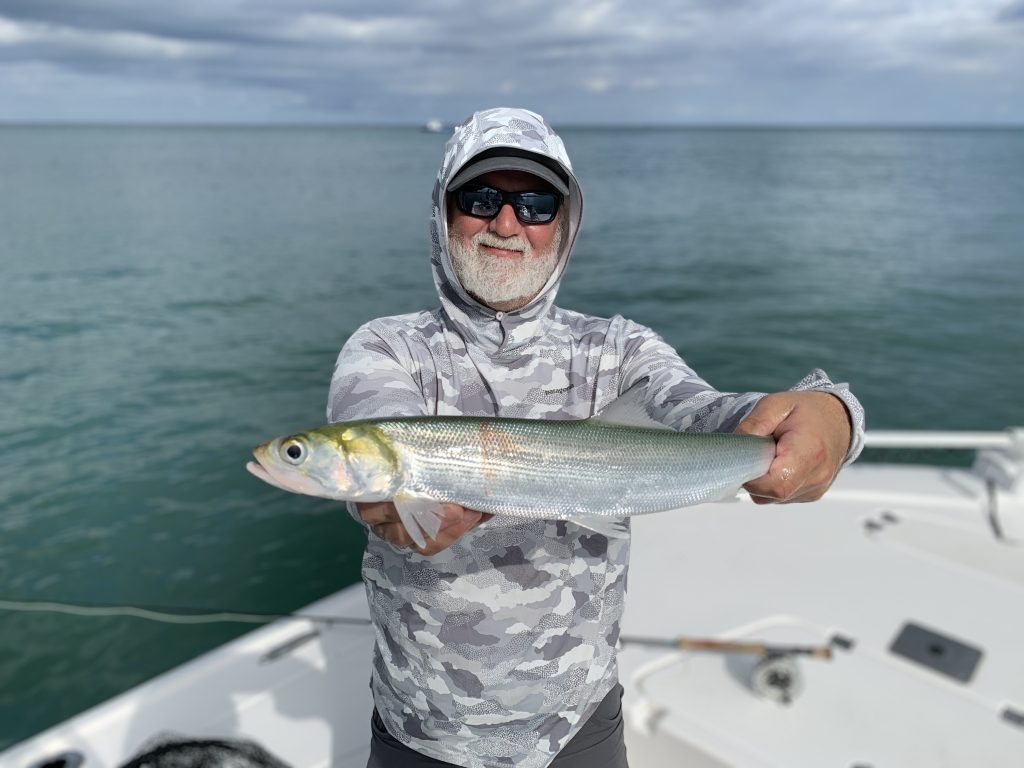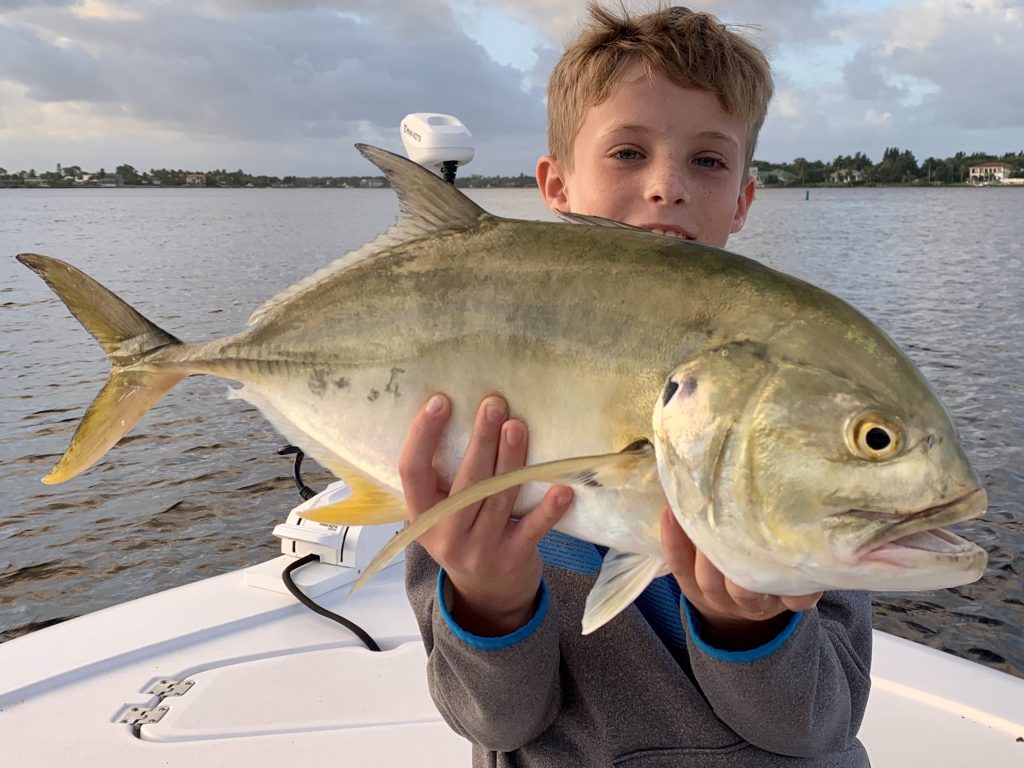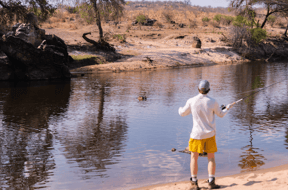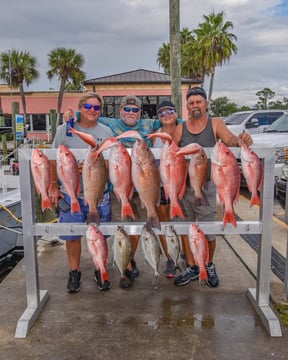Deep Sea, Nearshore Fishing in Destin
4 Hour Fishing Trip
Zambezi Escape
River Fishing in Dar es Salaam
Tanzania Tiger Fish Safari
Relaxing Offshore Special
Inshore, Nearshore, Jetty in New Smyrna Beach
Inshore Saltwater Run
Deep Sea Fishing in Fort Walton Beach
Chasing Lunkers Offshore Trip
Deep Sea Fishing in Fort Walton Beach
Badass Overnight Bluewater
Tabasco Snook & Tarpon Special
Destin Cobia Masters - 42’ Uniflite
Inshore, River, Flats in Jupiter
Jupiter Inlet On The Fly
We started Captain Experiences to make it easy to book fishing and hunting guides around the world. With over 2,000 Damn Good Guides, our platform makes finding and booking a trip seamless. Head here to check out our trips.
Setting the Tigerfish Park Record
With no idea what the new day will hold we head to a new section of the river, this one much more traditional - sandy banks, wide river, and grassy knolls overlooking prime fishing spots. This pool is much bigger and shallower - it is about a mile long and 50 yards wide, and maybe 15 feet deep in the middle (that we can guess).
We drive up to an old broken down pontoon crossing and start by casting off the miniature jetty. We spot some catauga up by the bank but cast at them to no luck and they scare away.
Everyone is still getting set up for the morning and getting their gear ready, and Austin is the first to get out of the gates. He walks downriver with one of our guards about 150 yards.
As the rest of us are still hooking up terminal tackle we hear some grunts followed by a yell from Austin, and then more yelling from George the guard. Familiar with the drill by now, we drop our gear and run down to meet them, and are presented with an absolutely massive tigerfish.
The fish is still on the line by the bank, and we watch George try to net it, but the fish is 10 inches too big for the net. We know we've got to land this giant, but getting down too close to the water means crocs can lash out with ease, and the tiger's teeth can find your fingers in seconds, even if you're reaching for its tail.
Against our better judgment and in the heat of the moment, we jump down into the shallows and grab the fish by the tail.
The sheer size of this fish is staggering. It is a giant silver slab of a fish. Austin can barely hold the fish as it shakes out of his hands upwards of 10 times in 30 seconds, each time posing a risk to a finger or a chunk of forearm with its teeth chomping through the air.
We rush to get some pictures and get this matriarch of a fish back in the water. As a general rule of thumb we usually catch tigers, work quickly to dehook, and then release headfirst from a distance to avoid getting too close to the dark water and the crocs lurking below the surface. In this case, we make an exception. After devouring the fly, it takes a bit longer to dehook this fish and we want to ensure a good release. With a close eye from the rest of us, Austin gets down to the water's edge and helps revive the fish, making sure she swims off strong.
Everything seems to stand still for a second.
I look at Austin, Austin looks at Dom, Dom looks at George, George looks at Rajabu, Rajabu looks at Jonathan who looks at Wolfgang. Everyone’s heart is absolutely pounding in their chest.
It seems like ten seconds pass before we all jump up and down and give each other huge hugs. We know that fish was massive. In the heat of the moment we had measured the fish against a rod and marked its length, and we cut a piece of line for measurement later. We head out to continue our day knowing that that piece of line held the key to a potential record fish.
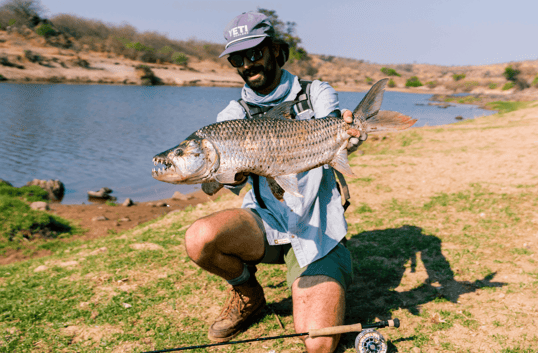
The new Ruaha National Park record tigerfish - 89cm caught on fly.
We later measured the fish at 89 cm (over 35 inches), beating the previous park record by almost 8 inches. George (one of our game guards) posted the picture to the park instagram, and it was re-shared on several Tanzanian news outlets. Austin became the “guy who caught the record” around town, or to us, “Bwana”, which means boss in Swahili.
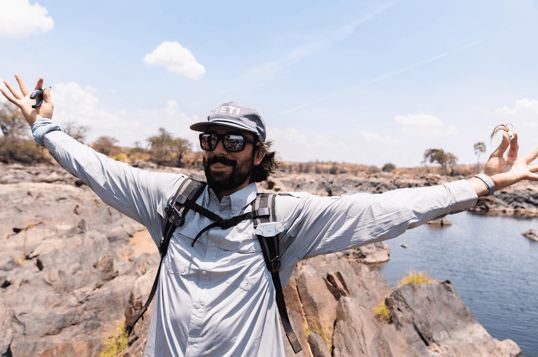
Euphoria.
Closing the Book on Tigerfishing Tanzania
We spend our remaining few days in Ruaha prowling far up and downriver and covering miles and miles of ground, essentially mapping out this section of the river and knowing its curves and rocks and deep pockets and underwater stumps like the back of our hands. We even begin calling spots by our new names for them: the pontoon, the tree, the bridge, the grassy knoll, the hippo pool, crocodile point, and the forbidden spot (George’s favorite spot).
We generally fish most of the day, trying to avoid the true heat of the day. Our days would be regularly broken up with game drives or animal sightings (we are in a national park, after all). On the third day in the park we leave fishing and 5 minutes later are watching lions taking down a baby giraffe.
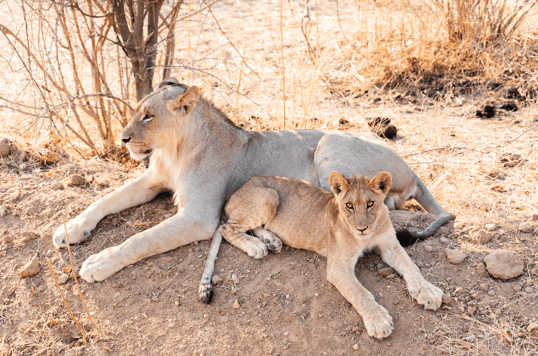
Two juvenile male lions (about 6 months and 1.5 years old) waiting for the pride to start the hunt.
We continue to experiment throughout our time here, and each catch 5-10+ fish per day by the end of the trip, although we leave thinking we still haven’t even begun to crack the code on these fish. They surprise us at every turn with their aggression, instinct, and odd behavior.
On day 3 Jonathan ran out of soft plastics and started walking the dog with a Googan Squad Salt Native silver swimbait with two treble hooks, and landed a big tiger, but while trying to hold the thrashing fish and take out the lure the tiger shook and thrust the other treble into his finger. The tigers are relentless, many a tiger will shake itself off the hook and back into the water all on his own. They are powerful and muscular and don’t give up.
On day 4 our buddy Doug from Asilia Lodges came to meet us and fish with us, and was catching some decent fish on a sizable silver spoon before a tiger snapped his rod in half.
On day 5 Doug and Dom traded turns catching crocodiles. Doug hooked 3 to Dom’s 1. The Crocodiles are relentless, and will chase a good-looking lure just like a tigerfish will. Luckily, just like the tigerfish it is hard to truly hook a croc.
On the last day, we got a goat from the local village and threw a party for the park rangers. We ate goat cooked over fire and rice with some veggies, and drank some Kilimanjaro beer and local gin while listening to Diamond Platnumz, one of the most famous hip hop artists to come out of Tanzania.
As it turns out, 5 out of 6 people who fished caught 60 cm+ fish. As for the sixth (myself), as the locals would say: “pore sana!” (roughly translated sarcastically as “you poor thing!”).
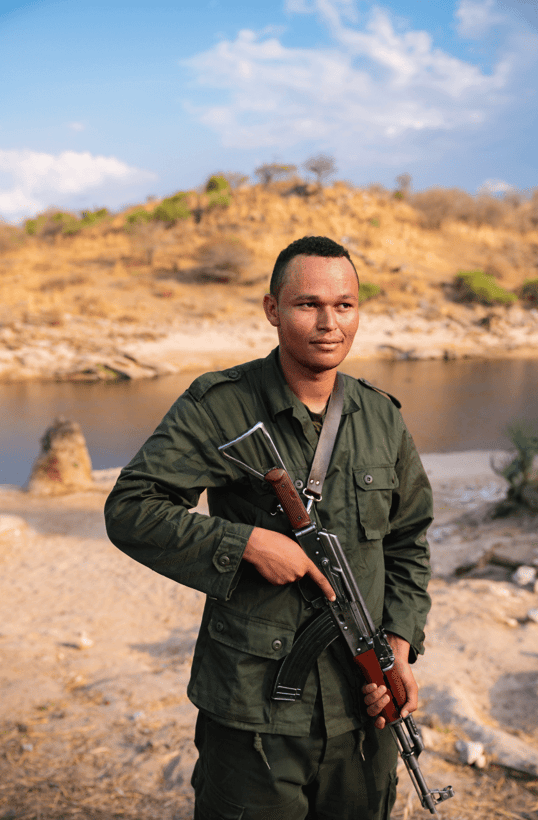
Our game guard George.
Bonus: Exploring New Ground - The Usangu Game Reserve
When you are fishing for tigerfish all day, you find yourself at times forgetting where you are and falling into old routines of casting, but you’ll look up and see 2 hippos staring at you, a croc on the far bank, a group of female kudu grazing across the way, and a male waterbuck drinking upriver. It is surprisingly easy (and dangerous) to forget where you are, especially as the environment here is oddly reminiscent of a dry south Texas ranch studded with a few palm trees and a hippo or two for good measure.
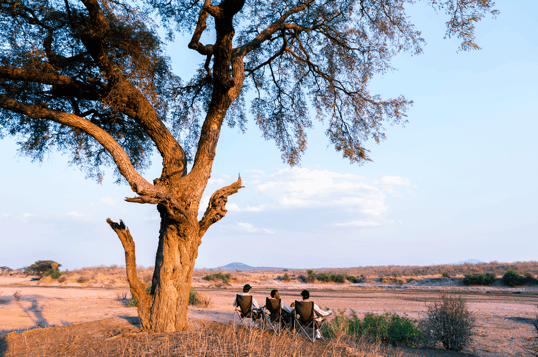
Looking over a mostly dry section of the river and enjoying a beer at the end of the day.
Our motivations for visiting Ruaha were twofold - one, world class tigerfishing. Two, world class safari game viewing. The icing on the cake of the latter (and hopefully a future destination for the former) has to be the Usangu Wetlands. Our Asilia host Doug wanted to host us in the Usangu Game Reserve, a southern offshoot of Ruaha NP. Asilia and Doug are working to build a fly camp down in Usangu, but this is previously uncharted territory - no roads here even existed until a few months ago (they were built by Doug and his team, in coordination with TANAPA), and we are 50 miles from the nearest ranger post in either direction.
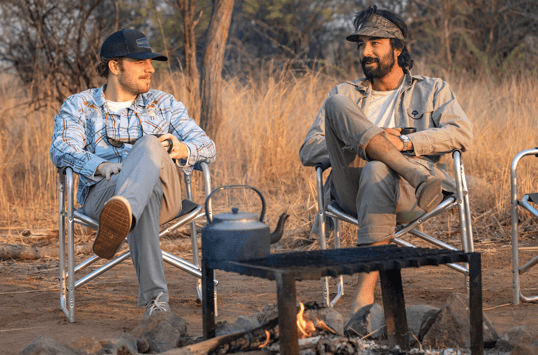
Sitting by the fire at the fly camp in Usangu.
Doug worked to scout the area by helicopter and by walking for weeks on foot with a pack, before working with the national park to add roads and access. The area chosen for the camp sits far upriver near the headwaters of the Ruaha. This area is marsh most of the year and the ground is all dried clay. Usually you can boat across the entirety of the wetlands instead of drive, but for now it is all open grassland with a few trees and plenty of sable antelope until we reach the Ruaha again.
This part of the river is narrower, but still flows even during the dry season. Once the waters reach downstream they will dissipate into the sandy bottom, but the river here is accessible only by boat. It is much narrower than our stretch of the river and much murkier, but spreads out and gets clearer as it is both combined with other creeks and filtered by the sand on its way downstream.
We take out an aluminum jon boat with a mud motor that was used to duck hunt the US in a past life (probably one of the only of its kind in Tanzania if not the entire region of Africa) and head out to scout the river.
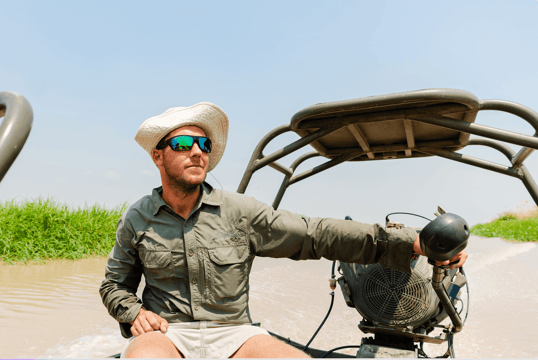
Doug piloting us up the upper Ruaha.
The river in general just seems so wild. There is a harmony in everything. The circle of life. You literally hear every animal noise within a span of ten minutes: angry grunting, happy grunting, shrieks of warning, and a few frantic splashes of someone’s last minutes before becoming dinner.
When you are in Tanzania (and especially in the national park), you are truly in the wilderness - this is not like a walk through a park in Texas where the baddest thing you might encounter is a boar. Every animal here is living on the edge and is a moment of not paying attention away from becoming something bigger’s dinner. No animals even seem to sleep (a hippo for example is nocturnal and by day it lounges underwater. They sleep a few hours by day in the water, but seem to consistently be monitoring us rather than resting).
Everything can also look so different but camouflage so well. You can get surprised by a giraffe 5 feet from the road. The longer you spend in the bush of the national park, the more you begin to embrace the wildlife and the way everything lives on the edge of existence. We take care to treat the tigerfish we catch well and release them strong, because we know the line between life and death here is razor thin.
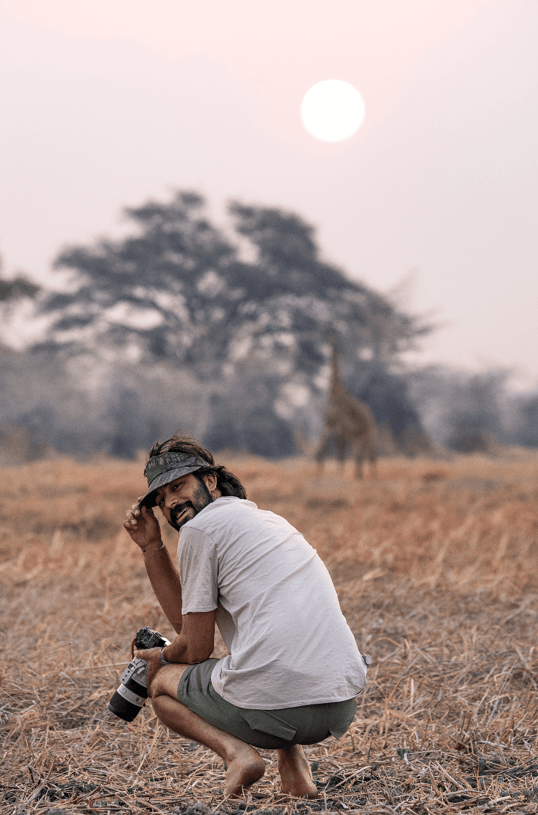
Austin working his angles to get a shot of a giraffe.
Conservation Efforts in Usangu
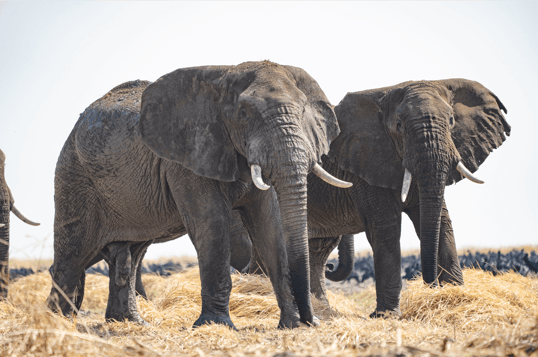
Elephants staring at us from the shoreline in Usangu.
We continue our push down the river in our boat, and see tens of thousands of birds, massive herds of hippo 200 strong, and multiple groups of big bull elephant. We would expect tigerfish to be just as plentiful, but sadly this is not the case.
Poachers have been in this area for decades. The national park only annexed Usangu a few years ago, but with no roads and no rangers, this part of the park has been all but run by locals for years. These poachers are not what you think - they are mainly hunting for subsistence, not ivory, but their methods are incredibly destructive to the animals and land.
As we drove into Usangu, we passed mile after mile of bush fires and burnt out areas (the ground and underbrush all burns, while the trees remain). Doug explains to us that poachers use game trails to travel and start uncontrolled burns for greater visibility. Fires remove thick and tall brush and leave behind dirt and trees, which help poachers avoid poisonous snakes and congregate game in more healthy areas so they are easier to find and kill.
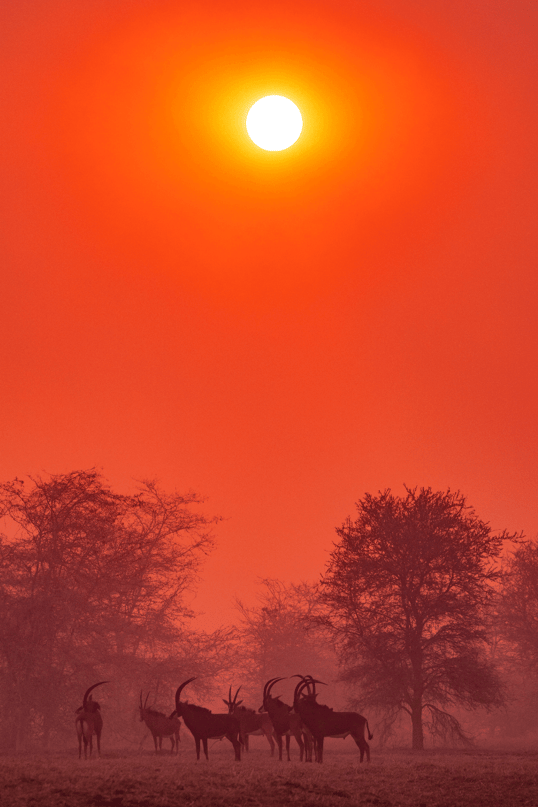
A herd of Sable antelope under a blood red sunset caused by poachers burning brush in the area.
While the area usually quickly grows back due to great soil, it’s awful to see, and directly contributes to animal deaths and loss of habitat. The sky in the area is smoky from the poacher fires and the falling sun is bright red, and while this makes for some incredible sunset viewing, it also reminds us of the tough decisions that need to be made to keep these areas pristine and keep populations intact.
The species that is arguably most impacted in this area is the tigerfish. Poachers camp by the river (their source of water for both themselves and their cattle, which they illegally graze on Usangu lands) and use homemade gill nets to catch anything they can for dinner. Often they use tiny nets, sometimes just throwing mosquito nets in the water and catching basically everything that swims by.
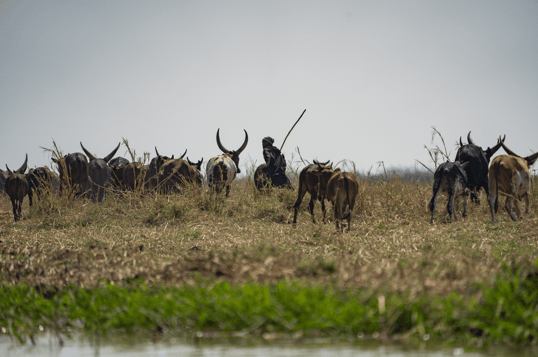
A poacher running his cattle away from the river.
The species that is most affected is the tigerfish - a predatory fish that swims miles up and downriver in a single day will hit a net every time, and poachers will pull up net after net of just tigers. Their teeth and large scales all but ensure they get trapped.
At this point in the dry season with the river disconnected from downstream sections like the ones we are fishing, the tiger population here has all but died out, and will only be replenished with the rains as tigerfish from downriver swim back up.
Knowing this, we didn’t bring our rods this time - there is no point - but we scope the river knowing that the rains will replenish populations and an angling presence here will improve the overall outcomes of these fish. Doug hopes to help the park remove poachers from the area and establish a presence of anglers. Anglers of course get to experience a virtually untouched part of the world and catch a world-class gamefish, but more importantly with outside anglers comes more attention and resources with which to guard and protect this wildlife (as well as more attention from the national park and its rangers).
We leave the river with mixed emotions. We came here to fish for tigerfish and as anglers we care deeply about conservation and the state of all waterways, both near and far. But we also feel for these so-called poachers. Many are just locals who have never known any different, or who are just trying to put food on the table. We don’t have answers to these questions, but we are eager for more awareness and education, and grateful for the work Doug has done in the area.
We agree with Dom, Doug, and the rangers on these issues - the solution seems to be tied to education and economics. Local community members must benefit more economically from conserving animal life than they would destroying it. Tourism brings jobs and outside money for these local communities, and helps incentivize all sides to protect the natural resources and wildlife of the area.
This is the third in a 5 part series:
Part 1: Habari, and Welcome to Tanzanian Fishing
Part 2: A Primer on Tigerfish Behavior
Part 4: 50 Miles to Latham Island
Part 5: Fishing for Rainbows in the Shadow of Kilimanjaro
Attison Barnes
Updated on July 31, 2023
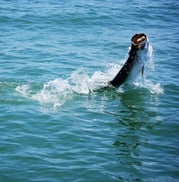
April 15, 2022
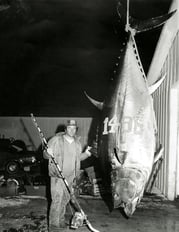
June 3, 2021

March 8, 2022

January 19, 2021

August 21, 2023
Related Articles
October 24, 2022
March 8, 2022
June 23, 2023
Featured Locations
- Fishing Charters Near Me
- Austin Fishing Guides
- Biloxi Fishing Charters
- Bradenton Fishing Charters
- Cabo San Lucas Fishing Charters
- Cancun Fishing Charters
- Cape Coral Fishing Charters
- Charleston Fishing Charters
- Clearwater Fishing Charters
- Corpus Christi Fishing Charters
- Crystal River Fishing Charters
- Dauphin Island Fishing Charters
- Daytona Beach Fishing Charters
- Destin Fishing Charters
- Fort Lauderdale Fishing Charters
- Fort Myers Fishing Charters
- Fort Walton Beach Fishing Charters
- Galveston Fishing Charters
- Gulf Shores Fishing Charters
- Hatteras Fishing Charters
- Hilton Head Fishing Charters
- Islamorada Fishing Charters
- Jacksonville Fishing Charters
- Jupiter Fishing Charters
- Key Largo Fishing Charters
- Key West Fishing Charters
- Kona Fishing Charters
- Lakeside Marblehead Fishing Charters
- Marathon Fishing Charters
- Marco Island Fishing Charters
- Miami Fishing Charters
- Montauk Fishing Charters
- Morehead City Fishing Charters
- Naples Fishing Charters
- New Orleans Fishing Charters
- New Smyrna Beach Fishing Charters
- Ocean City Fishing Charters
- Orange Beach Fishing Charters
- Panama City Beach Fishing Charters
- Pensacola Fishing Charters
- Pompano Beach Fishing Charters
- Port Aransas Fishing Charters
- Port Orange Fishing Charters
- Rockport Fishing Charters
- San Diego Fishing Charters
- San Juan Fishing Charters
- Sarasota Fishing Charters
- South Padre Island Fishing Charters
- St. Augustine Fishing Charters
- St. Petersburg Fishing Charters
- Tampa Fishing Charters
- Tarpon Springs Fishing Charters
- Venice Fishing Charters
- Virginia Beach Fishing Charters
- West Palm Beach Fishing Charters
- Wilmington Fishing Charters
- Wrightsville Beach Fishing Charters

